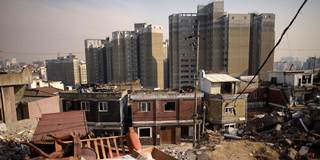Around the world, some 330 million urban households either live in substandard housing, or pay more for their housing than they can afford. And while subsidies, low-interest loans, and rent control may bring relief to households struggling with affordability, these measures will not solve the housing shortage.
ZURICH – From London to Lagos, “affordable housing” has become an oxymoron. In most cities, rents and home prices have increased faster than incomes, and in urban areas with robust job markets, housing stocks have failed to keep pace with demand. Some 330 million urban households either live in substandard housing, or pay more for their housing than they can afford. If current trends are not reversed, that number could grow to 440 million by 2025.
Without affordable housing, people suffer and economies stagnate. California’s housing shortage illustrates the problem. From 2009 to 2014, the state grew by 544,000 households but added only 467,000 homes. Today, amid a total housing shortfall of two million units, half of the state’s residents cannot afford to buy homes in their local market.
City governments are aware of the problem, and many are attempting to intervene. Unfortunately, many policies focus on demand and financing, rather than supply. Subsidies, low-interest loans, and rent control may bring relief to households struggling with affordability, but these measures will not solve the housing shortage. The only way to do that is to address two key challenges that have conspired to halt home building in many urban areas.

ZURICH – From London to Lagos, “affordable housing” has become an oxymoron. In most cities, rents and home prices have increased faster than incomes, and in urban areas with robust job markets, housing stocks have failed to keep pace with demand. Some 330 million urban households either live in substandard housing, or pay more for their housing than they can afford. If current trends are not reversed, that number could grow to 440 million by 2025.
Without affordable housing, people suffer and economies stagnate. California’s housing shortage illustrates the problem. From 2009 to 2014, the state grew by 544,000 households but added only 467,000 homes. Today, amid a total housing shortfall of two million units, half of the state’s residents cannot afford to buy homes in their local market.
City governments are aware of the problem, and many are attempting to intervene. Unfortunately, many policies focus on demand and financing, rather than supply. Subsidies, low-interest loans, and rent control may bring relief to households struggling with affordability, but these measures will not solve the housing shortage. The only way to do that is to address two key challenges that have conspired to halt home building in many urban areas.